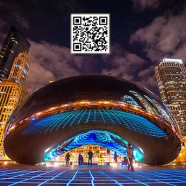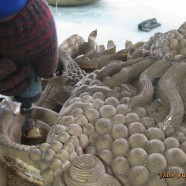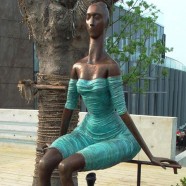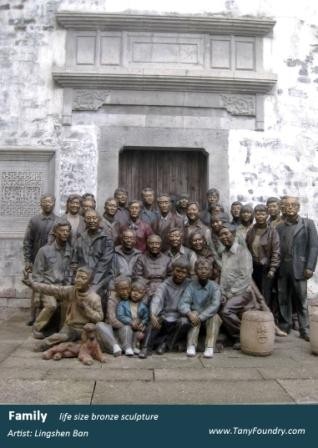Trending of Combination of Sculpture and Internet
Nowadays technology, especially the smartphone and internet, has been radically reshaping every aspect on our life. Of course sculpture is not an exception. I have a few random thoughts on how the smart phone and mobile internet can possibly change the way viewers interact with the sculpture and its artist. ( the sculpture above is by renowned artist Anish Kapoor ) In the future, every public art will have its own 2D barcode. Viewers can use their phone to scan the barcode and it leads them to a web page, allowing them to Browse more background info on this piece of work: why and how it is made, The page can even play some video clips on the manufacturing process. The page even allows viewers to interact with the artist in a living way. I can imagine it is not difficult to connect with the barcode with an instant messager like Skype or Google Talk. The viewers can chat with artist, ask questions and get answered, etc. The artist’s bio, his/her career path, other works, his own statement of this work. You can see, at this stage, the relation between artwork, viewers and artists has changed. It is more interactive; it deepens viewer’s understanding about the work and the artist. The viewers get more involved with public art. On the other hand, with some statistic data, artist can even know how many people view his work, like or dislike the work. Honest feedback is possible now. I can expect the trending will be around corner. What do you think ? I expect your comments. ...
Read MoreArt Foundry Field book for Sculptor Series
Knowing the capacity and limit of foundry tools is important for sculptors who want to create a piece of successful art work. Even with the best design and intention, it can realize within the capacity of foundry tool. I am planning to write a series posts on the common tools art foundry use for casting bronze/ aluminum sculptures, which may be useful for sculptors who want to know how to use proper tool to achieve the ideas artistic effect he/she wants. This time I’d like to a tool: air scribe, which plays an important role in finishing bronze casting or aluminum casting. As we know, many sculptures features very nice details and texture. However, it is never easy to achieve that without careful chasing and finishing work. Air Scribe is one of the useful helpers we use to do that. Below is a video clip on how we use the scribe. Here are a few features you can employ from air scribe It rotates rapidly and powerfully to make the bronze casting smoother. The scribe can replaced with tools with different hardness and diameter, fit for different purpose. It is suitable for using after bronze chasing to refine some details and texture on bronze casting. We recommend choosing the proper size scribe according to the bronze sculpture you are working on. You have to be very careful when handling small pieces with high level of textured details. A smaller diameter scribe works best on those pieces. Starts from slower speed and make it faster when necessary. We are using an air scribe to do finishing on a piece of bronze cast sculpture. ( Silicon Bronze) It works quite well on the finishing job. The detail is becoming clear and smooth. Feel free to let me know if you have any question....
Read MoreHow to Choose Best Casting Technique for Sculpture
The quality and cost of bronze / aluminum casting for sculptures is greatly affected by the casting technique a foundry employ. Tany Foundry summarize the related knowledge according to its past experience and create this chart to help artist to choose the optimal technique for their sculptural projects. Lost wax casting Sand casting Technical WorkflowMaster pattern - Rubber Molding - Wax - ceramic shelling - Bronze casting - Chasing - Finishing - Patina Master pattern - Sand molding - Bronze casting - Chasing - Finishing - Patina Eligible casting material for sculptural project - Bronze; - Brass; - Aluminum; - Stainless steel;- Bronze; - Brass; - Aluminum; - Stainless steel; Key StepsRubber Molding; FinishingSand Molding; Finishing Ideal project scopeSmall and medium sized works with textured details ( e.g: life size bust and figurative sculpture )Medium to monumental works with less details Pros- Lost wax casting can represent details of the sculpture very well, especially sculpture with lots of textures; - It costs less when you need to cast multiple editions from the same rubber mold; - There is no molding line like sand casting, which means better finishing quality of bronze- The foundry can gain much bigger one single bronze casting piece from sand casting; - It can minimize the potential distortion happening during bronze casting, which means better integrity and nice shape. - It costs ess than lost wax casting on monumental sculpture and the turnaround time is shorter. Cons- It costs more than sand casting when it is monumental sculpture. - The casting may get distorted, especially for the sculpture with geometry shape like straight line and edges. - The turnaround time is longer than sand casting because a rubber mold and wax is required before casting.- Sand casting is not very good to capture complciated textured details on sculpture like lost wax casting. - It requires very experienced artisans to perform sand molding - There may be trace of molding line left on the surface of sculpture. Below are a few cases made by Tany Foundry. Lost wax casting Sand casting ...
Read MoreBeauty of Chaos: Stainless Steel Fabrication Sculpture
People love colors. Public artists have been exploring using color for their works for many years. Recently, Tany Foundry, the leading art fabrication service in China, work with local public artist Min Chiang on a stainless steel fabrication wall sculpture with gradual changed colors. From designer’s own words, “I want the viewers to find the beauty from chaos”. Here is the brief description on the how we make it. Project Name: The Beauty of Chaos Size: 5 Meters long Material: Stainless steel sheet Grade 316 Wall Thickness: 2.5 MM Production: Fabrication Finishing: Two part epoxy powder coating The Challenge of this work: coat gradual changed color on sculpture. First we fabricate the sculpture with stainless steel sheet. We use stainless steel Grade 316 to make sure its corrosion resistant performance.We use water jet cutter to cut stainless steel sheet to the desired size. Water jet cutting is controlled by computer with very high accuracy on the size of cut. Because of the size of the sculpture, we have to work on them section by section. Then we hammer the pattern on the stainless steel sheet. The pattern is designed by artist. It is very important to make sure the pattern is continues and sections are fit well. After that, we assembly sections of stainless steel fabrication to form one single piece. Finally, our artisan powder coat the sculpture with two part epoxy. The challenge of doing the coating is that the color of the sculpture is not a mono tone. There are several colors on the sculpture and they are gradual changed. We need present the beauty of Chaos just like the name...
Read More18 Feet tall bronze Relief Column: Story
People are always interested in story, even in the time of internet. People tell story in different ways. Sculpture is of of the most interesting ways. Now Tany Foundry is working on some 18 feet tall bronze relief columns called Story. The relief depicts the story and lifestyle of ancient Chinese people: where they lived; how they did their work, the interaction between people and nature. We make the story interesting to viewers and let them travel back to the good old days to see and feel how their ancestors lived their lives. This project is commissioned by our local government. Designer: Guo Deshen Project Name : Story; 18 feet tall bronze relief column Dimension : 18 feet tall Material: 2 MM thick bronze sheet Method: bronze fabricated and hammered. Status: ongoing. Ready for patina. Brief process: first we sculpt on clay the relief. Then we make fiberglass mold from the clay work. Then we fabricate and hammer the sculpture. Finally, we do patina. The designer Mr.Guo offers us drawing of the relief. We sculpt it with clay and make fiberglass. All of the work is done by our experienced artisans. This bronze relief depicts the view of countryside of ancient times. You can see clearly the ox and houses on the relief. The details of the relief. You can see the country house and the trees. This relief is about a famous poet in ancient China. The upper left is his poem. All characters are clearly engraved and the shape is clear to see. The details of the relief. There are mountains, temple and trees on the relief. All of them are fabricated manually by our artisans. Our artisan is working on the relief. He has 30 years experience. Some bronze reliefs we are working on. They are ready for patina. The bronze relief columns are to be installed in our local museum. ...
Read More5 Tips on Saving Budget on Sculpture Casting
In the down economy, it is important for sculptors to keep the cost of foundry service within the budget. With decades years’s experience on working in art casting. Tany Foundry would like to give some tips on how to save cost on foundry service. Choosing an affordable sculpture foundry The cost of sculpture casting service varies dramatically. One of the reason is the cost of labor and the technique they use. The cost difference is as much as twice or three times, depending on the size of your work. We suggest you to choose a foundry with Lost wax casting capacity when you have small or medium size works. Sand casting capacity when your have monumental bronze or aluminum sculpture to make. Sand casting can shorten the mold making process therefore reduce the related cost. However, it is not fitting for those sculpture with high details. You can seek local foundry with sand casting capacity ( there are not many in the US) or look for a foundry overseas. It makes sense if using an oversea foundry can help you save cost significantly. Choosing from a acceptable material for your project There are several options of material for your sculptures. Bronze : most commonly used metal for sculpture. You can do different patina on it. Also, it is one of the most expensive among metal casting. Brass: lower bronze percentage than bronze and cheaper than bronze. Patina options are also less then bronze. However, if you plan to do painting on the metal instead of patina, there is few difference between bronze and brass. Aluminum: lighter and cheaper than bronze. It is an economical material and useful when your budget is limited. Please note unlike bronze, it is difficult to do patina on aluminum. Usually people do painting on aluminum. Stainless steel: it’s not so often used in art casting. Also, it is even more expensive than bronze. Stainless steel is more used in sculpture fabrication than casting. Making mold and wax work yourself It can save your money from foundry service if you are able to make mold yourself. The charge of mold making varies among foundries, some takes up to 30% or higher of the total bronze casting cost. Therefore, making mold can help you a portion of the total cost. From our experience, it costs much less in Asia foundry like Thailand or China. Enlarge Sculpture with CNC milling instead of by Hand CNC milling is more and more used in sculpture enlargement. Though it still requires for some touch up work on finishing, it can save your time and money significantly. One thing worth noting is that you need to pay more attention on your Maquette because any imperfection will become significant after enlargement. Casting multiple pieces if possible. It can save you money if you can cast multiple pieces at the same time. Foundry can cast the multiple pieces at one turn and the marginal cost is small. If you have any tips on saving cost, please share with us. Thanks. ...
Read More



